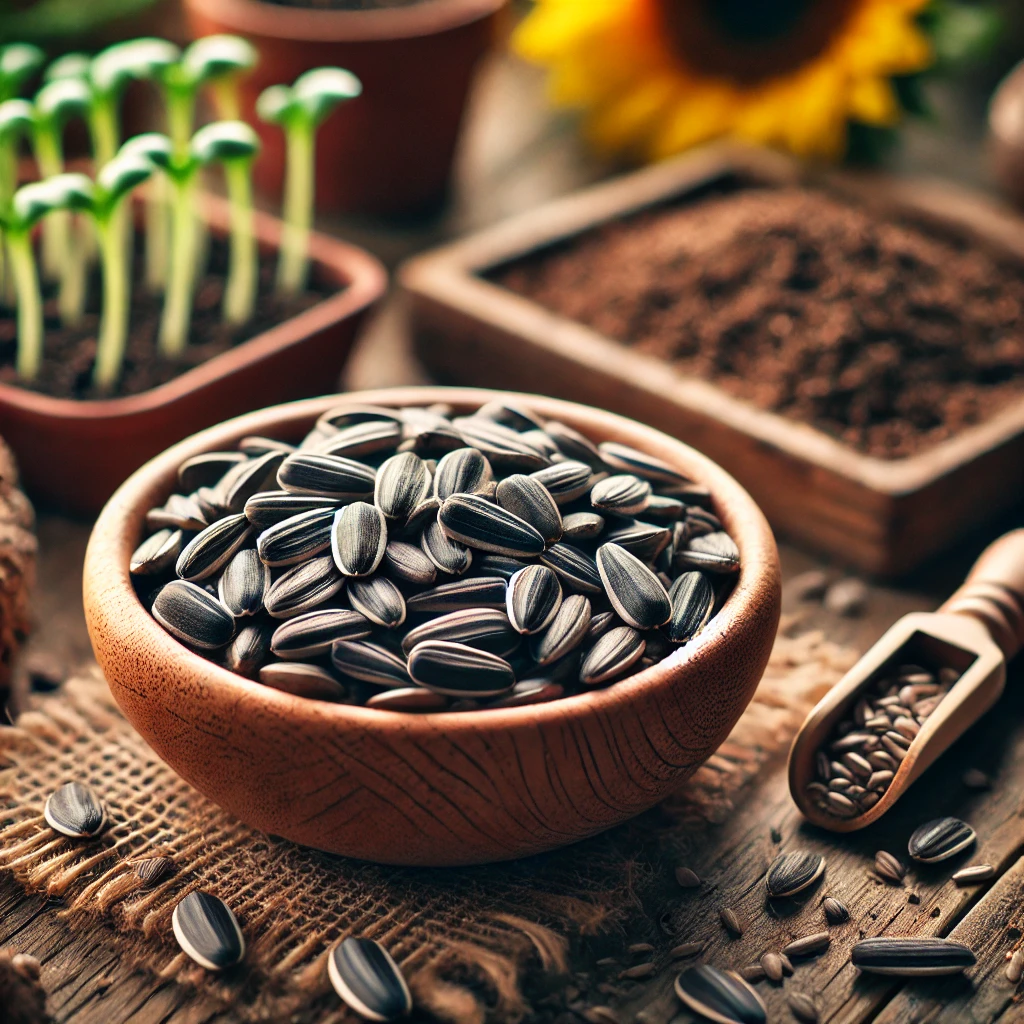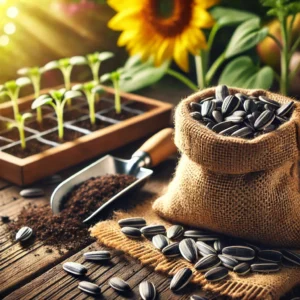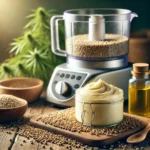
sunflower seeds for planting
Introduction: Sunflower Seeds For Planting & Growing
Sunflowers are among the most iconic and cheerful plants you can add to your garden. Their towering height, vivid blooms, and versatility make them a favorite for gardeners of all experience levels. Whether you’re looking to grow them for their beauty, to harvest seeds, or attract pollinators, sunflowers offer endless benefits. In this comprehensive guide, we’ll walk through everything you need to know about sunflower seeds planting, from choosing the right seeds to ensuring a successful harvest. sunflower seeds for planting.
Why Sunflower Seeds For Planting Are a Perfect Addition to Any Garden
Sunflowers (Helianthus annuus) are not only aesthetically pleasing, but they also play a vital role in promoting a healthy garden ecosystem. These bright blooms attract beneficial insects like bees and butterflies, making them a natural way to boost pollination in your garden
Moreover, Sunflower Seeds For Planting grow quickly and require minimal care, making them ideal for novice gardeners. Their versatility extends beyond aesthetics—sunflowers can provide edible seeds, oils, and even livestock feed
Sunflower Seeds For Planting from seeds offers the added joy of watching the entire life cycle of the plant, from a tiny seed to a towering giant that can stand up to 12 feet tall. Plus, sunflower seeds are generally easy to find, inexpensive, and available in many varieties tailored for different uses.(Read more)
Step 1: Choosing the Right Sunflower Seeds for Planting
Before you start Sunflower Seeds For Planting, it’s essential to choose the variety that best suits your needs. Sunflowers come in a range of sizes and colors, from the classic giant yellow blooms to more unique shades of red and orange. Each type has its purpose, so be mindful of the space available in your garden and your overall gardening goals.
Popular Sunflower Seeds For Planting Varieties
-
Mammoth Sunflowers: Known for their extraordinary size, mammoth sunflowers can reach heights of up to 12 feet. They produce large flower heads that are perfect for harvesting sunflower seeds. Their towering presence makes them a dramatic feature in any garden
-
Dwarf Sunflowers: These are perfect for gardeners with limited space or for container planting. Varieties like ‘Teddy Bear’ reach only about 2 feet in height but produce vibrant and fluffy-looking flowers. They are ideal for smaller spaces or if you prefer a more compact sunflower
-
Branching Sunflowers: This type produces multiple flowers on a single plant, offering an extended blooming season. These are ideal for gardeners who want to create a continuous display of sunflowers throughout the season
Seed Quality and Sourcing
It’s important to purchase high-quality Sunflower Seeds For Planting, especially if you’re aiming to harvest seeds for consumption. Always opt for untreated, non-GMO seeds if you’re planting for edible purposes. Organic seeds are also a great option for eco-conscious gardeners
Step 2: When and Where to Plant Your Sunflower Seeds
The timing and location of your Sunflower Seeds For Planting can greatly impact the growth and health of your plants.
Ideal Planting Time
Sunflower Seeds For Planting are warm-weather plants that thrive in temperatures above 50°F (10°C). The best time to plant sunflower seeds is in late spring, after the last frost has passed. In colder regions, you can start seeds indoors 4 to 6 weeks before the last expected frost date and transplant the seedlings outside once the danger of frost has subsided
If you’re aiming for a continuous bloom throughout the summer, consider staggered planting every two weeks. This way, you’ll have sunflowers blooming all season long.
Choosing the Perfect Location
Sunflowers love sunlight—ideally, they need about 6 to 8 hours of direct sunlight each day. Choose a sunny spot in your garden with well-draining soil. Sunflowers can tolerate various soil types, but for optimal growth, it’s best to amend your soil with compost or organic matter before planting Avoid planting in areas prone to waterlogging, as this can cause root rot.
Step 3: Planting Sunflower Seeds
Direct Sowing in the Garden
One of the simplest ways to grow sunflowers is by sowing the seeds directly into the garden. This method minimizes transplant shock and allows the plants to establish their roots immediately. Here’s how to do it:
-
Prepare the Soil: Loosen the soil to a depth of about 6 inches and remove any weeds or debris. Sunflowers are deep-rooted plants, so ensure that the soil is well-draining and rich in organic matter
-
Planting the Seeds: Plant the seeds about 1 inch deep and space them 6 to 12 inches apart, depending on the variety. Larger varieties like Mammoth Sunflowers will need more space, while smaller or branching varieties can be planted closer together
-
Watering: After planting, water the seeds thoroughly. Keep the soil consistently moist, especially during the early stages of growth. Sunflowers are relatively drought-tolerant once established, but young plants need plenty of moisture
Starting Indoors Sunflower Seeds For Planting
If you live in a region with a short growing season, starting sunflower seeds indoors can give your plants a head start. Use small pots filled with seed-starting mix and plant one seed per pot, about 1 to 1.5 inches deep. Keep the pots in a warm, sunny location and water regularly Once the seedlings develop their first set of leaves, harden them off by gradually exposing them to outdoor conditions before transplanting them into the garden.
Step 4: Caring for Your Growing Sunflower Seeds For Planting
While sunflowers are generally low-maintenance, providing them with some basic care will ensure they thrive and produce stunning blooms.
Watering and Fertilization
Sunflowers need regular watering during their growing phase, especially in the early stages. Aim to provide about 1 inch of water per week. Once the plants are established, they can tolerate periods of drought, but they’ll perform best if kept in moist (but not waterlogged) soil
Fertilizing is optional but can help if your soil lacks nutrients. A balanced, slow-release fertilizer applied at the time of planting will encourage healthy growth.
Staking and Support
Tall sunflower varieties, especially those with magnificent, large flower heads, can benefit from staking to help them stand strong and proud, even in the face of strong winds, ensuring they continue to thrive and showcase their beauty.. Use bamboo stakes or garden twine to support the plants as they grow. Place the stakes early in the growing season to avoid disturbing the roots
Step 5: Harvesting Sunflower Seeds
One of the most rewarding aspects of growing sunflowers is harvesting the seeds. Depending on the variety, sunflowers will reach maturity and be ready for harvest in 70 to 100 days
Signs Your Sunflowers Are Ready for Harvest
-
The back of the flower head turns yellow or brown.
-
The seeds are plump and start to loosen in the flower head
Harvesting and Storing Seeds
To harvest, cut the flower heads off the plant, leaving about 12 inches of stem attached. Hang the heads upside down in a dry, well-ventilated area for about a week to allow the seeds to dry completely Once the seeds are dry, you can easily rub them off the flower head. Store them in an airtight container in a cool, dry place if you plan to use them for eating or planting next season.
Step 6: Companion Planting with Sunflowers
Sunflowers make excellent companions for a variety of other plants. Their tall stalks can provide shade for more delicate plants, while their deep roots help break up compacted soil. Consider planting sunflowers alongside crops like cucumbers, which can benefit from the light shade provided by the towering sunflower stalks
Additionally, sunflowers attract beneficial insects like bees, which will help pollinate other plants in your garden. However, keep in mind that sunflowers can compete for resources, so be mindful of planting them too close to smaller, more sensitive plants
Conclusion: Sunflower Seeds for Planting—A Rewarding and Joyful Experience
Growing sunflowers from seeds is an enjoyable and fulfilling experience. With their towering beauty, edible seeds, and ability to attract pollinators, sunflowers offer a multitude of benefits to gardeners. Whether you’re planting them for their aesthetics, their seeds, or their role in supporting your garden’s ecosystem, sunflowers are a versatile and low-maintenance addition to any garden.
By choosing the right seeds, providing the necessary care, and harvesting at the right time, you’ll be rewarded with stunning blooms and a bountiful harvest. Whether you’re a beginner or a seasoned gardener, sunflowers bring both beauty and utility to your outdoor space.



